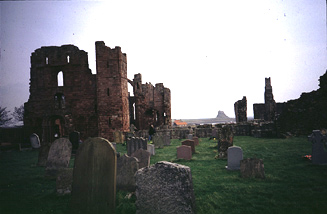
Ruined Monastery at Lindasfarne
(Castle in the Distance)
©Daniel W. Mosser

Ruined Monastery at Lindasfarne
(Castle in the Distance)
©Daniel W. Mosser
In the eighth century, something caused the Scandinavians to become restless. They began series of attacks: the Norwegians conquered parts of British Isles and the Danes, in the tenth century, founded Dukedom of Normandy. According to the Anglo-Saxon Chronicle, the raids in England began in 787 and continued off and on until about 850. They included the sacking of the monasteries of Lindasfarne and Jarrow in 793 and 794. After that, there was a hiatus until 834 when raids were renewed and continued up to 850.During what is generally regarded as the second stage of Scandinavian influence, large armies arrived, and in addition to plundering, the Danes began to establish settlements. In 850, a Danish fleet of 350 ships wintered in Thanet (an island in the Thames) and in the spring captured Canterbury and London. They were later defeated by the West Saxon army. In 866, a large Danish army plundered East Anglia and in 867 captured York. In 869, Edmund, the king of East Anglia, was killed.
King Alfred, driven into retreat in the march country of the Southwest by the invading Danes, rallied his armies and defeated the Danes overwhelmingly at Ethandun (modern Edington, Wilts.) in 878. The Treaty of Wedmore was established in the same year, marking the culmination of the second wave of invasions. The Treaty did not expell the Danes, but rather defined the limits of their rule: the northeast of England, north of a boundary line running from Chester in the northwest, to London. This area became known as the Danelaw. The Danes also accepted Christianity, and Guthrum, the Danish leader who had signed the treaty with Alfred, was baptized.
The third stage of Scandinavian Influence, the years between 872 and 1042, was a period of political adjustment and assimilation. The Danes still tended to break the treaty, and new invaders followed. Alfred's son, Edward the Elder (900-925), and his grandson Athelstan (925-939), carried on counter-attacks. The year 937 saw Athelsan's triumph in the Battle of Brunanburh in Northumbria, commemorated in the Anglo-Saxon Chronicle by the poem of the same name.
In 991, a fleet of 93 ships under Olaf Tryggvason entered theThames. The invasion was met by Byrhtnoth, who was killed after a valiant struggle in the Battle of Maldon (click here for the poem with sound files; click here for biboliography). As a consequence, the English had to pay series of large bribes to prevent further plunder. By 1012, the amount had grown to £48,000 (roughly equivalent to $100,000,000 in present-day currency, according to Robert Claiborne [90]).
Svein, King of Denmark, who had joined forces with Olaf in 994 (who himself later became King of Norway), had designs on the English throne. Aided by his son, Cnut, in 1014 he defeated Æthelred Unræd ("the un-advised"), the English King, and drove him into exile. When Svein died the same year, Cnut succeeded him, and the Danes ruled England for the next 25 years. In the eleventh century King Cnut occupied the thrones of Denmark, England, and Norway (Danish & Norman Kings of England).
The Anglo-Saxons and the Scandinavians shared many aspects of culture in common, and their languages--both branches of Germanic--were also closely related. The Five Buroughs--Lincoln, Stamford, Derby, Leicester, and Nottingham--were the center of Scandinavian influence (the Battle of the Five Buroughs in 942 is commemorated in another Chronicle poem). Since the influx of Scandinavians continued, the language was constantly reinforced, though many of the settlers learned English or were bilingual due to intermarriage.
In Old English, the "sh" sound was spelled sc; in Old Norse, the language of the Vikings, the same spelling signified the pronunciation sk. Thus the PDE words ship, shirt, shall, shrub, and fish descend from the Anglo-Saxon wordstock, while skin, skill, scrape, skirt, and scrub come from Old Norse. Old Norse also had the velar "hard k" sound following i, giving us dike, while Old English had the palatal "ch" sound in the same environment, giving us ditch. Where Old English had the glide pronunciation for the spelling g before high front vowels, Old Norse had the palatal ("hard g") pronunciation, resulting in the everyday words get, give, and egg. The latter three terms are examples of native Old English words being replaced by Old Norse words. Even more basic "English" words derived from Old Norse are the "th-" pronouns (they, their, them), and the verb form are, which replaces the Old English sindon. Other Old Norse replacements inculde:
Old English
Old Norse
sweoster ("sister")
syster
niman
take
weorpan
cast
wolken ("welkin")
sky
eyethurl (eye+thurl ["hole"])
vindr (wind)+auga ("eye")=> "window"
Sometimes, the Old Norse term enters as a synonym for the Old English word:
Old English
Old Norse
no
nay
whole
hale
rear
raise
from
fro
craft
skill
hide
skin
sick
ill
starve
die
The Danelaw occupation leaves behind more than 1400 place-names in England, containing Scandinavian elements such as these:
- -by ("farm, town") as in Grimsby, Derby, and the term "by-law"
- -thorp ("village") as in Althorp, Bishopsthorpe
- -toft ("a piece of ground, messuage") as in Eastoft, Nortoft
- -thwaite ("an isolated piece of land"), as in Applethwaite, Cowperthwaite

Web Links
Recordings of OE at UVa
Old English resources at UVa